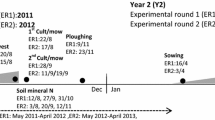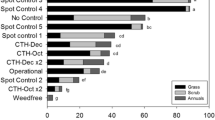Abstract
In order to determine if herbicide efficacy is affected by nitrogen fertilizer, the influence of different nitrogen fertilizers applied in different combinations with hexazinone formulations were evaluated on herbaceous weed communities. Field studies comparing three application methods in conifer plantations showed greatest reduction in total weed cover with a co-granular formulation of hexazinone and triamino-s-triazine. Slightly less control was achieved with separate applications of liquid hexazinone and triamino-s-triazine granules, and poorest control with granular urea followed by liquid hexazinone. Weed control increased with an increase in hexazinone rate. Statistical analysis of the effect on conifers showed that the highest hexazinone rate significantly increased survival of noble fir (Abies procera Rehd.) and stem diameter of both noble fir and Douglas-fir (Pseudotsuga menziesii (Mirb.) Franco), and that the highest nitrogen rate significantly decreased survival of both species but did not affect stem diameter. Survival of noble fir and diameter of both noble fir and Douglas-fir were significantly increased where a co-granular formulation of hexazinone and triamino-s-triazine granules was used.
Similar content being viewed by others
References
Albertson, F. W. and Weaver, J. E. 1945. Injury and death or recovery of trees in prairie climate. Ecol. Monogr. 15: 393–433.
Bailey, A. W. and Gupta, R. K. 1973. Grass-woody plant relationships. Can. J. Plant Sci. 53: 670–676.
Blaisdell, J. P. 1949. Competition between sagebrush seedlings and related grasses. Ecology 30: 512–519.
Detrick, J. 1986. MCI Ag Systems Interim Report. 1981–1984 Forestry experimentation: Extended weed control and nitrogen nutrition. Donaldsonville, LA.
Fales, S. L. and Wakefield, R. C. 1981. Effects of turfgrass on the establishment of woody plants. Agron. J. 73:605–610.
George, E. J. 1943. Effects of cultivation and the number of rows on the survival and growth of trees in farm windbreaks on the northern Great Plains. J. For. 41: 820–828.
Harris, L. E. and Hyslop, G. R. 1942. Selective sprays for weed control in crops. Oregon Agric. Exp. Sta. Bull. 403: 1–31.
Johnsgard, G. A. 1963. Temperature and water balance for Oregon weather stations. Oregon State Univ. Ag. Exp. Sta. Spec. Rep. 150.
Little, T. M. and Hills, F. J. 1978. Agricultural experimentation design and analysis. John Wiley and Sons, New York, 350 p.
McWhorter, C. G., Jordan, T. N. and Wills, G. D. 1980. Translocation of C-glyphosate in soybeans (Glysine max) and johnson grass (Sorghum halepense). Weed Sci. 38: 113–118.
Miller, J. M. 1984. New biochemical methods for conifer reforestation. Ph.D. dissertation, Univ. of Washington, Seattle, WA.
Nielson, A. P. and Wakefield, R. C. 1978. Competitive effects of turfgrass on the growth of ornamental shrubs. Agron. J. 70: 39–42.
O'Sullivan, P. A., O'Donovan, J. T. and Hamman, W. M. 1980. Influence of non-ionic surfactants, ammonium sulphate, water quality and spray volume on the phytotoxicity of glyphosate. Can. J. Plant Sci. 61: 391–400.
Petersen, T. D. 1988. Effects of interference from Calamagrostis rubescens on size distributions in stands of Pinus ponderosa. J. Appl. Ecol. 25:265–272.
Petersen, T. D. and Maxwell, B. D. 1987. Water stress of Pinus ponderosa in relation to foliage density of neighboring plants. Can. J. Forest Res. 17: 1620–1622.
Petersen, T. D. and Newton, M. 1985. Growth of Douglas-fir following control of snowbrush and herbaceous vegetation in Oregon. Down Earth 41: 21–25.
Preest, D. S. 1977. Long-term growth response of Douglas-fir to weed control. N. Z. J. Forest Sci. 73: 329–332.
Szabo, S. S. and Buchholtz, K. P. 1961. Penetration of living and non-living surfaces by 2,4-D as influenced by ionic additives. Weeds 9:177–184.
Tischer, N., Quimba, G. P. and Bejuki, W. B. 1951. Activators which considerably increase the defoliant and phytotoxicity properties of endothall. Proc. Northeast. Weed Control Conf. 5: 35–44.
Turner, D. H. and Loader, M. P. C. 1972. Some increases in efficacy of foliage-applied herbicidal salts due to the addition of ammonium ions. Proc. Br. Weed Control Conf. 11: 654–660.
1975. Further studies with additives: Effects of phosphate esters and ammonium salts on the activity of leaf-applied herbicides. Pestic. Sci. 6: 1–10.
1978. Complexing agents as herbicide additives. Weed Res. 18: 199–207.
1980. Effect of ammonium sulfate and other additives upon the phytotoxicity of glyphosate to Agropyron repens (L.) Beauv. Weed Res. 20:139–146.
1984. Effect of ammonium sulfate and related salts on the phytotoxicity of dichlorprop and other herbicides used for broadleaf weed control in cereals. Weed Res. 24: 67–77.
Tustin, J. R., Knowles, R. L. and Klomp, B. K. 1979. Forest farming: A multiple land-use production system in New Zealand. Forest Ecol. Manage. 2:169–189.
Weller, S. C., Skroch, W. A. and Monaco, T. J. 1985. Common bermudagrass (Cynodon dactylon) interference in newly planted peach (Prunus persica) trees. Weed Sci. 33: 50–56.
White, D. E. and Newton, M. 1984. Glyphosate and hexazinone mixtures: Effects on weeds and Douglas-fir transplants. Forest Res. Lab., Oregon State Univ., Corvallis. Res. Note 76, 5 p.
Wills, G. D. and McWhorter, C. G. 1985. Effect of inorganic salts on the toxicity and translocation of glyphosate and MSMA in purple nutsedge (Cyperus rotundus). Weed Sci. 33: 755–761.
Author information
Authors and Affiliations
Rights and permissions
About this article
Cite this article
White, D.E., Witherspoon-Joos, L. & Newton, M. Herbaceous weed control in conifer plantations with hexazinone and nitrogen formulations. New Forest 4, 97–105 (1990). https://doi.org/10.1007/BF00119003
Accepted:
Issue Date:
DOI: https://doi.org/10.1007/BF00119003




